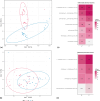Low-gainer diet-induced obese microbiota transplanted mice exhibit increased fighting
- PMID: 39212186
- PMCID: PMC11362840
- DOI: 10.1111/cts.13906
Low-gainer diet-induced obese microbiota transplanted mice exhibit increased fighting
Abstract
Weight gain variation is a great challenge in diet-induced obesity studies since low-gainer animals are of limited experimental value. The inbred C57BL/6 (B6) mice are frequently used models due to their genetic homogeneity and susceptibility to diet-induced obesity (DIO). The aim of this study is to investigate if the gut microbiota (GM) influences the fraction of low weight gainers in DIO studies. A total of 100 male B6 mice (donor population) were fed a high-fat diet for 14 weeks and divided into the study groups high gainer (HG) and low gainer (LG) based on their weight gain. Subsequently, fecal matter transplantation (FMT) was done on germ-free B6 mice with GM from HG and LG donors (FMT population). LG (13.35 ± 2.5 g) and HG (25.52 ± 2.0 g) animals were identified by the weight gain from week 1 to week 12. Interestingly, the start weight of the LG (20.36 ± 1.4 g) and HG (21.59 ± 0.7 g) groups differed significantly. Transplanting LG or HG fecal matter to germ-free mice resulted in significant differences in weight gain between HG and LG, as well as differences in serum leptin levels and epididymal fat pad weight. A clear LG-specific GM composition could not be distinguished by 16S rRNA gene amplicon sequencing. Surprisingly, significantly more fighting was recorded in LG groups of both donor populations and when transplanted to germ-free mice. The HG and LG phenotypes could be transferred to germ-free mice. The increased fighting in the LG group in both studies suggests not only that the tendency to fight can be transferred by FMT in these mice, but also that fighting should be prevented in DIO studies to minimize the number of LG animals.
© 2024 The Author(s). Clinical and Translational Science published by Wiley Periodicals LLC on behalf of American Society for Clinical Pharmacology and Therapeutics.
Conflict of interest statement
MK is employed by Novo Nordisk. CMJM is funded by a LIFEPHARM grant that is co‐funded by Novo Nordisk A/S. AKH declares that he has collaborated with and received funding from pharmaceutical and food industry as declared on
Figures





References
-
- Collins S, Martin TL, Surwit RS, Robidoux J. Genetic vulnerability to diet‐induced obesity in the C57BL/6J mouse: physiological and molecular characteristics. Physiol Behav. 2004;81(2):243‐248. - PubMed
-
- Reuter TY. Diet‐induced models for obesity and type 2 diabetes. Drug Discov Today Dis Model. 2007;4(1):3‐8.
-
- Montgomery MK, Hallahan NL, Brown SH, et al. Mouse strain‐dependent variation in obesity and glucose homeostasis in response to high‐fat feeding. Diabetologia. 2013;56(5):1129‐1139. - PubMed
-
- Surwit RS, Kuhn CM, Cochrane C, McCubbin JA, Feinglos MN. Diet‐induced type II diabetes in C57BL/6J mice. Diabetes. 1988;37(9):1163‐1167. - PubMed
MeSH terms
Substances
Grants and funding
LinkOut - more resources
Full Text Sources
Medical

